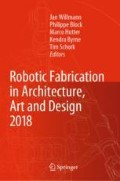Abstract
This paper explores the ventures of the Robotic Fabrications AA Visiting School. Cultivating and implementing radical and innovative modes of architectural fabrication, we borrow from neighbouring creative fields such as choreography, performance and martial arts - efficient code being infected with an exciting spatial complexity and positing an artistic engagement within the world of physical production.
Access this chapter
Tax calculation will be finalised at checkout
Purchases are for personal use only
Notes
- 1.
Robotic Fabrications is run by director Emmanuel Vercruysse and tutor Zachary Mollica with the robotics team of Pradeep Devadass, Gary Edwards and recently, Michael Arnett. Authors Emmanuel and Zachary are respectively a co-director and studio tutor for the AA’s Design + Make programme. At the time of the work presented, author Pradeep Devadass was AA Hooke Park’s Robotics Developer as part of a collaboration between the AA, UWE and KTP.
- 2.
The authors, as faculty for the AA’s Design + Make programme, gained significant expertise in working with complex inherent timber forms through the Wood Chip Barn project (2016). ‘Chainsaw Choreographies’ expanded on the extensive workflows established [2].
- 3.
While the robotic arm operates with sub millimeter precision, through close observation, the chainsaw was found to resonate up to 4 mm due to the arm’s inflexibility and lack of damping.
- 4.
The Chainsaw uses a bar of approximately 400 × 60 × 4 mm, while the bandsaw’s kerf is much thinner and restricted by the 400 mm cutting gate between its two wheels.
- 5.
Chainsaws for example may be mounted with ripping (for cutting along grain) or crosscutting (for cutting across grain) chains – each possessing a different tooth profile. Impractical to switch between each operation, the arms feed rates are instead adjusted to compensate – simulating the human operator. With the bandsaw, a trade off is made between speed of cutting (requiring a large tooth pitch) and minimum turning radius (requiring a finer band/tooth).
References
Sato, H., Nakahara, Y., Paul Nii, K. (Trans): The Complete Japanese Joinery. Hartley & Marks, Vancouver (1995)
Mollica, Z., Self, M.: Geometric strategies for exploiting inherent material form. In: Adriaenssens, S., Gramazio, F., Kohler, M., Menges, A., Pauly, M. (eds.) Advances in Architectural Geometry 2016, pp. 138–153. vdf Hochschulverlag ETH Zurich, Zurich (2016)
kkaarrlls homepage. http://www.kkaarrlls.com/index.php?feature=editions,7Xstool. Accessed 12 May 2018
Pawlofsky, T.: Rhino2krl. In: Brell-Çokcan, S., Braumann, J. (eds.) ROB|ARCH 2012: Robotic Fabrication in Architecture, Art and Design, pp. 166–171. Springer, Vienna (2013)
Yuan, P.F., Chair, H.: Robotic wood tectonics. In: Sheil, B., Menges, A., Glynn, R., Skavara, M. (eds.) Fabricate: Rethinking Design and Construction, pp. 45–49. UCL Press, London (2017)
Johns, R.L., Foley, N.: Bandsawn bands: feature-based design and fabrication of nested freeform surfaces in wood. In: McGee, W., Ponce de Leon, M. (eds.) Robotic Fabrication in Architecture, Art and Design 2014, pp. 17–32. Springer International Publishing, Switzerland (2014)
“Nuki Tsuke” [digital image] (n.d.). https://shinbukan-paris-iaijo.tumblr.com. Accessed 8 May 2018
Salmon, G.: Kendo: A Comprehensive Guide to Japanese Swordsmanship. Tuttle Publishing, Rutland (2013)
Davies, K., Vercruysse, E., Svilans, T., Dodd, I.: Instruction and instinct, performing within unordered complexity. In: McGee, W., Ponce de Leon, M. (eds.) Robotic Fabrication in Architecture, Art and Design 2014, pp. 223–232. Springer International Publishing, Switzerland (2014)
Author information
Authors and Affiliations
Corresponding author
Editor information
Editors and Affiliations
Rights and permissions
Copyright information
© 2019 Springer Nature Switzerland AG
About this paper
Cite this paper
Vercruysse, E., Mollica, Z., Devadass, P. (2019). Altered Behaviour: The Performative Nature of Manufacture Chainsaw Choreographies + Bandsaw Manoeuvres. In: Willmann, J., Block, P., Hutter, M., Byrne, K., Schork, T. (eds) Robotic Fabrication in Architecture, Art and Design 2018. ROBARCH 2018. Springer, Cham. https://doi.org/10.1007/978-3-319-92294-2_24
Download citation
DOI: https://doi.org/10.1007/978-3-319-92294-2_24
Published:
Publisher Name: Springer, Cham
Print ISBN: 978-3-319-92293-5
Online ISBN: 978-3-319-92294-2
eBook Packages: Intelligent Technologies and RoboticsIntelligent Technologies and Robotics (R0)

